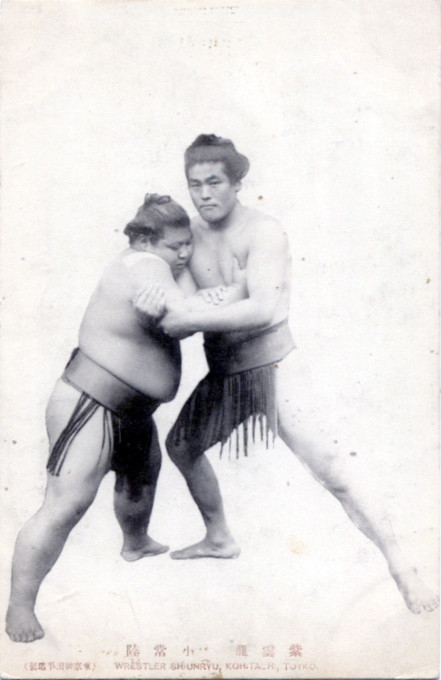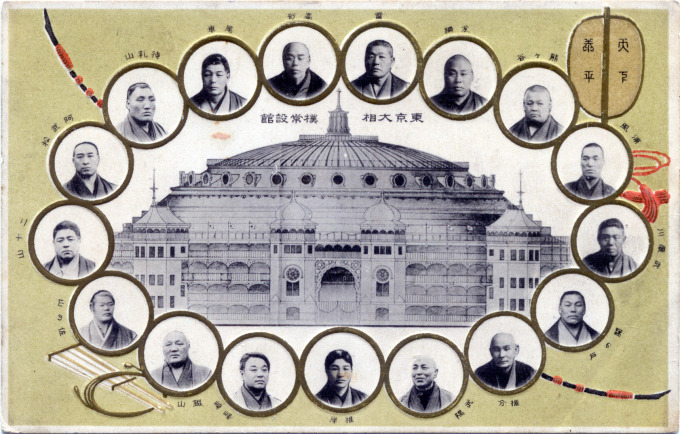
Sumo wrestlers Shiunryu & Kohitachi (right), c. 1910. Born in Tokyo on February 9th 1886, Kohitachi Yoshitaro was adopted by the Yokozuna-to-be Hitachiyama. He entered Dewanoumi beya [sumo stable] with a weight of about 73 kg. His first appearance on a banzuke [sumo ranking list] was in May 1902. He reached the Juryo division in May 1907 and it took him only two basho [sumo tournament] to become the 661th makuuchi [“inside the curtain”, the top division in sumo] in sumo history, in May 1908. Kohitachi died on September 15th 1927, at the age of 41.
See also:
Kokugikan (National Sport Hall), c. 1910-1950
Sumo wrestler Hitachiyama, c. 1910.
Otokonoko (“young boy”) sumo “wrestler”, c. 1910.
“Wrestling (sumo) is one of the most popular of the Japanese sports, and the bouts held in Tokyo in Jan. (usually from the 12th to the 22d) and May of each year arouse as much enthusiasm as baseball does in the U.S.A.
“Wrestlers in Japan are as unmistakable as bull-fighters in a Spanish country. They are immensely heavy, gladiator-like, beefy men, sometimes weighing 300-350 lbs. and standing head and shoulders above the average native. It is said that they observe no special regimen in their diet, other than that they eat two or three times as much meat as the ordinary native and drink considerably more sake than the average man.
“Legend traces the practice to one Kehaya (nicknamed the ‘quick-kicker’), a man of extraordinary strength, who lived at Toma, in Yamato Province about B.C. 23. His pride in his muscle became known to the Emperor Suinin, who sent for Nomi-no-Sukune, a strong man of Izumo; the two wrestled in the presence of the Sovereign, and Sukune’s attacks were so rude that Kehaya died on the spot from the injuries received.
“Posterity refers to this as the first recorded wrestling-match; the place in Yamato still known by the name Koshi-orida, or ‘hip-breaking field,’ is said to mark the place where Kehaya died.
“… The first public matches (hatsu-zumo) on record in Yedo took place in 1632; though several times prohibited by the authorities, the bouts grew in importance and frequency, and about 1820 the temple inclosure of Eko-in became the established center of the annual exhibitions.
“Ancient wrestlers were classified according to their skill, and competing squads were called ‘right and left’ sides. The present classification of ‘Eastern and Western Camps’ dates from Tokugawa times and is believed to represent the E. and W. provinces respectively.
“Prior to 1868 wrestlers enjoyed privileges almost as great as those of samurai, to whom they were next in military rank. Their treatment was in marked contrast to that of actors, who were referred to as ‘riverside beggars,’ and who were compelled when traveling to hide their faces in deep wicker hats.”
– Terry’s Japanese Empire, by T. Philip Terry, 1914


